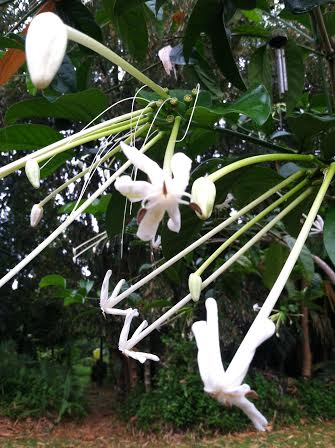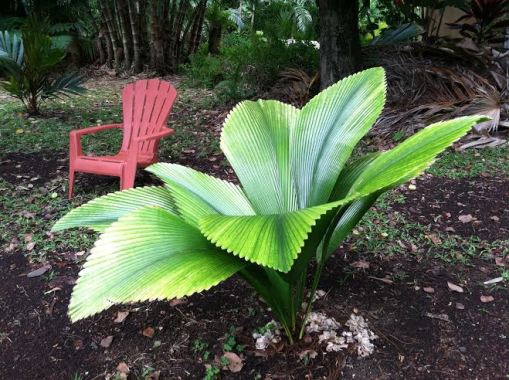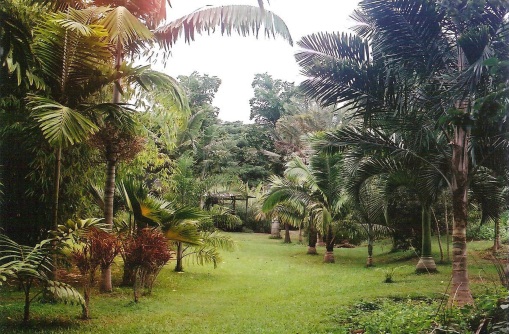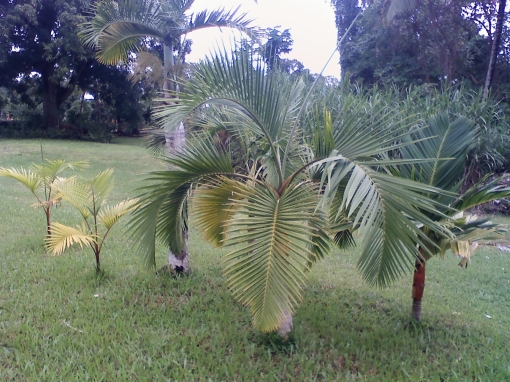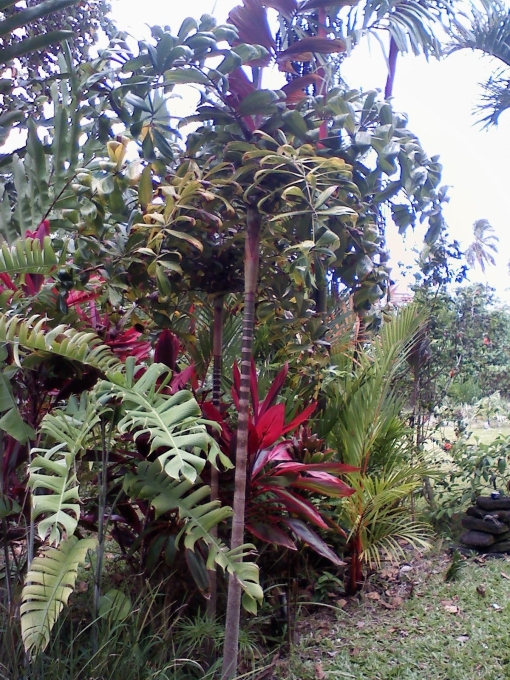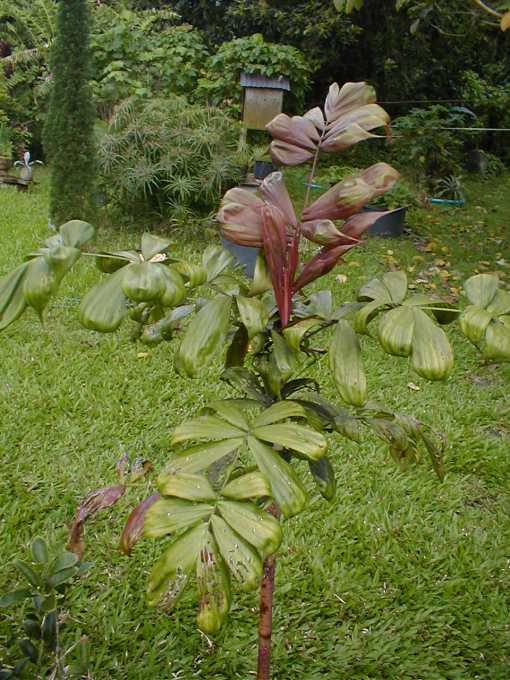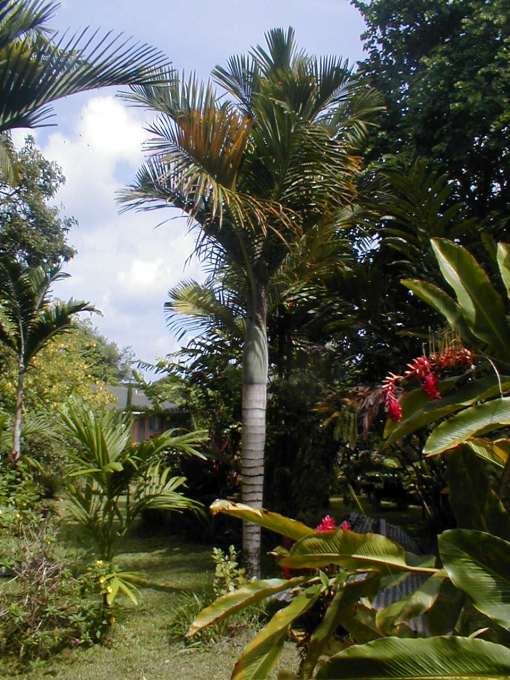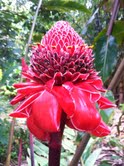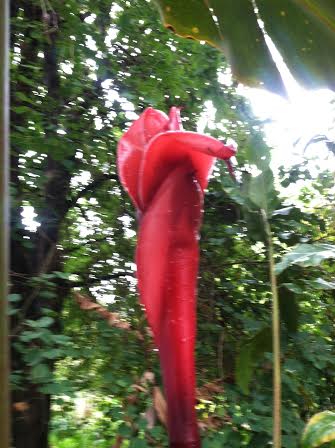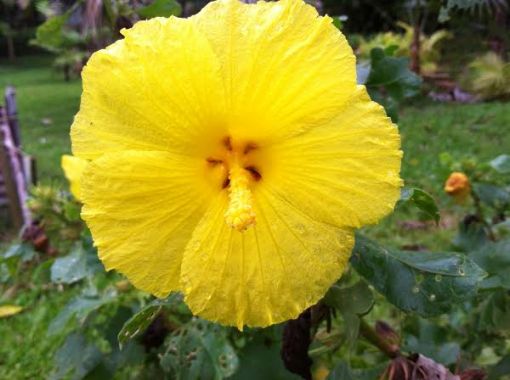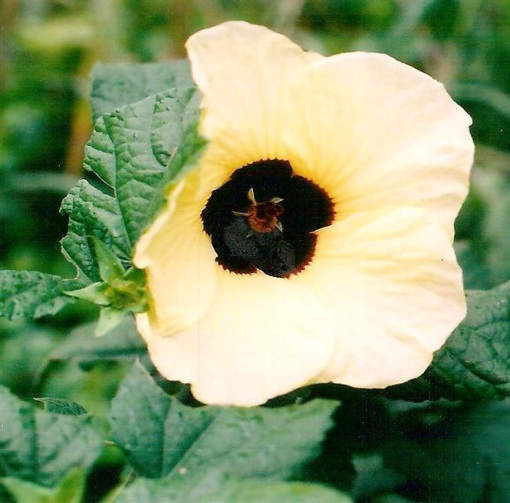

This is a Pritchardia munroi, the sole survivor of the members in Palm Row. This is “Shaggy” a loulu endemic to West Maui and East Molokai. We named him on account of the shaggy skirt he wears; persistent leaf bases cause some trees to hold on to their dead leaves.

This is the first Pritchardia palm that I acquired and started me on the road to collecting the rest of the species in this genus. This palm is no longer. It was growing at our former residence, but was cut down by a tenant who wanted the space to park his vehicle. This is a Pritchardia thurstonii or Thurston Palm, thought to be one of two ancestral species of all the native Hawaiian Pritchardia or loulu as we call them here.

This Pritchardia hillebrandii grows on the southeast ridge at Pa Kanu Ola in Wakiu, Hana, Maui. It’s a hardy palm that is native to Molokai.

This is the view looking west on the southeast ridge.; young Pritchardia pacifica are seen on the left foreground and a Dypsis carlsmithii and a couple Areca catechu fill the right half.

This Pritchardia arecina growing just up the road in Nahiku was planted in a small private arboretum by Marion Cabral. It is the source of seeds that I have germinated and grown into trees over the years. There are several offspring growing in Pa Kanu Ola.

I collected this Pritchardia beccariana from a forest near the volcano on the Big Island. It was just a young seedling barely clinging to life with little to no nutrition. It now grows at our former residence in, Wakiu.

This is a Pritchardia forbesiana seedling that was planted in Pa Kanu Ola some years back. It is quite mature today, though it has yet to flower and seed.

This is a view through the crown of a Pritchardia remota growing on the central flat of the garden. This species is natiive to the islands of Nihoa and Niihau.
Heliconia blossoms are quite durable; they last a good spell and maintain their glow. They make for attractive floral displays in large spaces.

There is a growing collection of flowering shrubs, bushes and trees at Pa Kanu Ola. The initial gathering has been one of native Hawaiian flora; and then those flowering plants with enticing scents and exotic beauty. This white ginger is not common at this time, though it may grow to be so in short order.
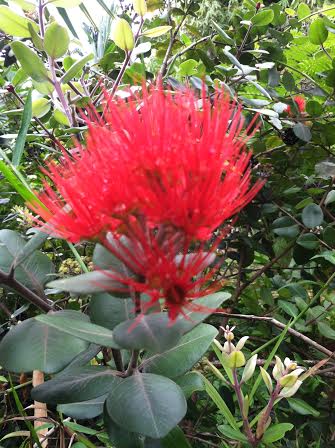
This is the red variety of the New Zealand Ohi’a; there is also an orange variety growing in the garden.
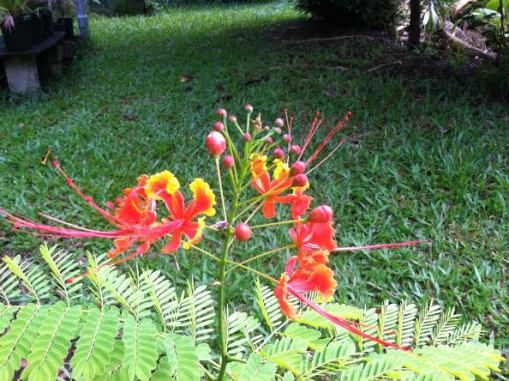
This orange and yellow “Ohai Ali’i comes close to Hawaii’s royal colors; the other two varieties: pure yellow and scarlet are all growing in the garden.

Among our fruit trees are star apples; though we started out with banana and citrus, we soon added fruit bearer to what was growing on the acreage when we started the garden in 1990.

Though one can find strawberry guava growing in the wild along the highway, we like having it on hand in the garden.

The cacao bean trees seem to do well out in the sun. The trees I planted in shadier areas are not producing fruit as well. We’ll be clearing some of the overgrowth in those areas soon to give them more sunlight.
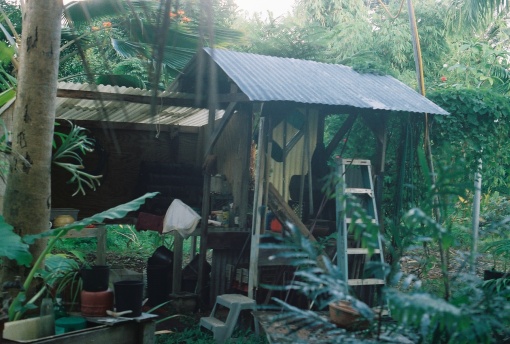
The Garden Office, where the plants all get their start; we have an extension indoors for the paperwork
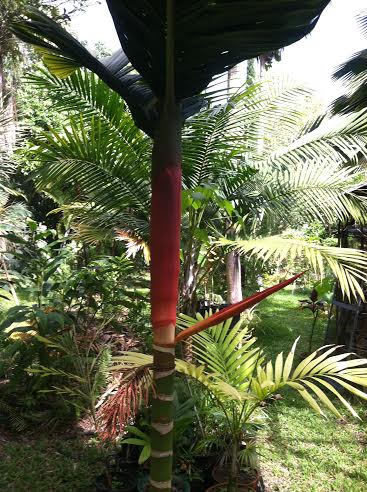
The Areca macrocalyx blooming with color as it displays its first bract of flowers; the second is still wrapped in its casing.
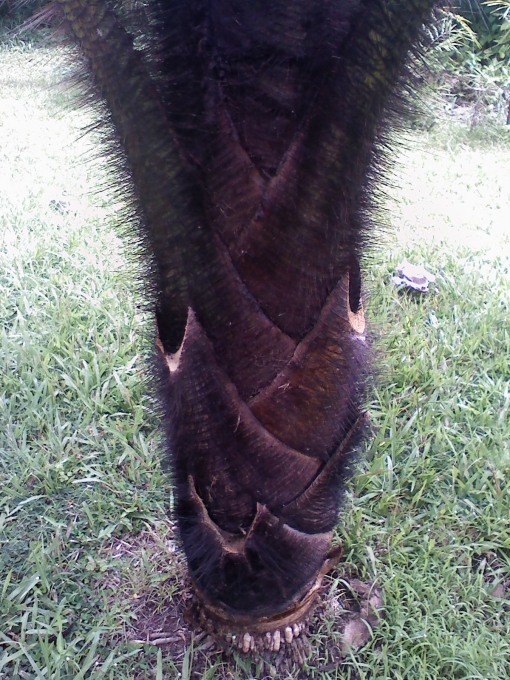
Pigafetta trunk detail. Plants that are susceptible to animals feeding on them tend to grow protective thorns. Most shed the thorns when they have grown above the reach of the animals. This we see is true in the case of the palm Deckenia nobilis, but not so for Pigafetta elata. At about fifty feet in height, spines are still produced on the petioles and leaf bases.

Dypsis onilahensis (close up of trunk base); the penciling of the trunk indicates the plant is dwindling.
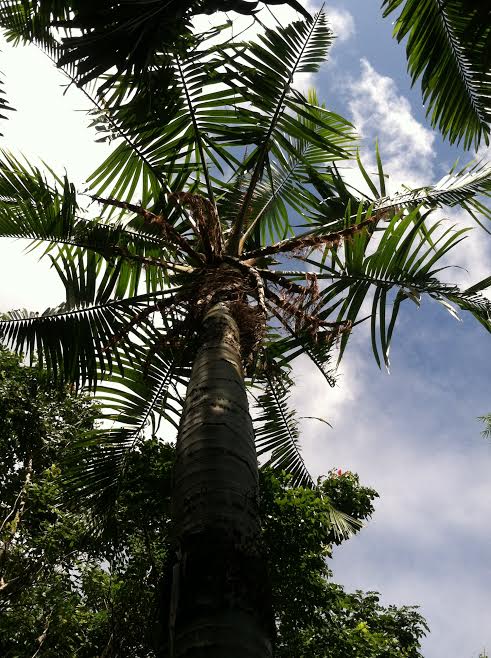
This photo shows the Pigafetta elata at its current height with approximately thirty feet of trunk.

We used to call these palms “the three bears”; the common name of Dypsis leptocheilos is “Teddy Bear Palm”. They are pictured on the central flat in the garden; only one is still there.. The other two were relocated to another garden not long after this photo was taken.

One of the fastest growing palms in the world, Pigafetta elata is known to grow three feet of trunk in a year. The tree above was planted in the ground in 2008. The following photo shows this palm in recent days; its trunk is now about sixteen feet tall.
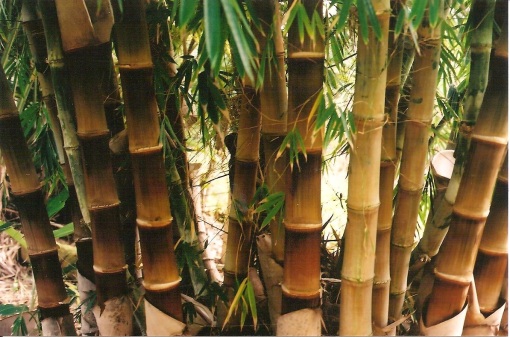
I’m told that this patch of Dendrocalamus asper will grow with each set of new shoots until the culms reach a diameter of eight inches and the stalk get up to nearly one hundred feet in height. They’re past the halfway point already.
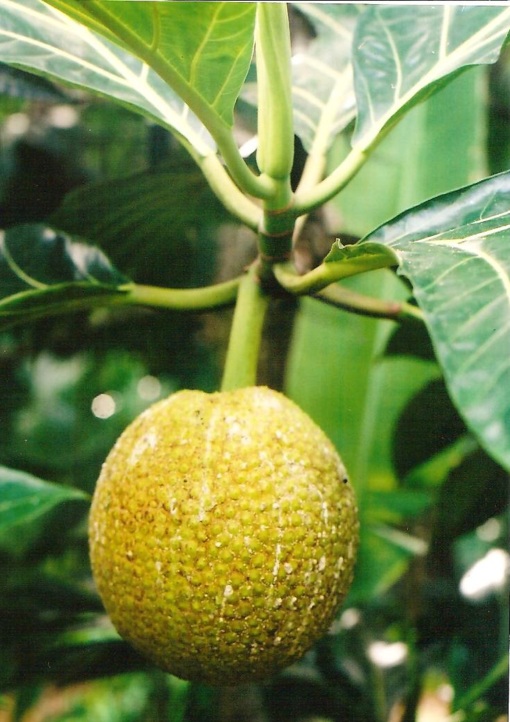
Breadfruit “Ulu” has been growing on the property for ages. We have propagated some young trees to add to the old growth and to sell in the nursery.
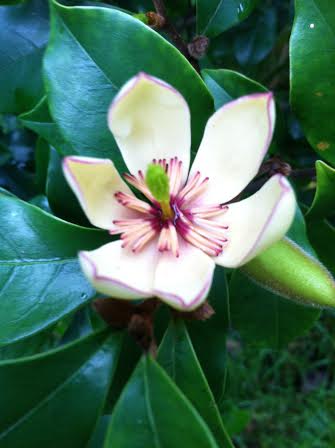
Sometimes, when we cannot find the name of a plant, we give it our own until we learn otherwise. This we call the “bubblegum flower”; it smells like bubble gum.
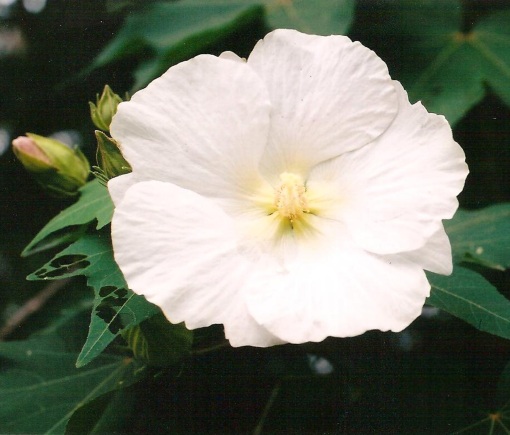
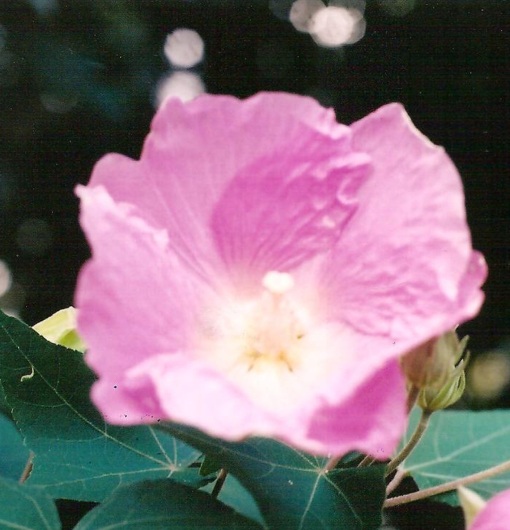
But as the sun approaches the western reaches of the sky, our “transforma hibiscus” takes on an ever deepening pink as the day passes on.



